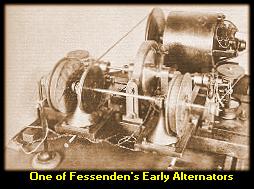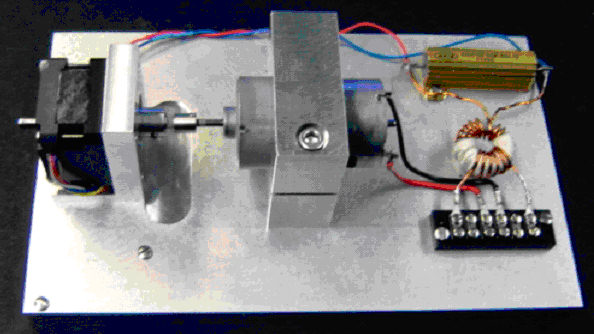|
 2006 2006
SIMULATION OF FESSENDEN'S
CHRISTMAS EVE BROADCAST
by John S. (Jack)
Belrose, VE2CV, VY9CRC
Peter Bouliane, VE3KLO
|
|
In 1906 Reginald Aubrey Fessenden, using an HF Alternator, modulated by
an asbestos covered microphone in series with his tuned antenna system,
made a pre-announced (3-days earlier) Christmas Eve broadcast, to US
Navy Warships, and ships of the United fruit Company, using Fessenden
type receivers
The Christmas Eve program as recounted by Fessenden consisted of:
"... first a short speech by me
saying what we were going to do, then some phonograph music.... Then
came a violin solo by me ... which I sang one verse of, in addition
to playing the violin, though the singing, of course, was not very
good. Then came the Bible text, Glory to God in the highest and on
earth peace to men of good will, and we finally wound up by wishing
them a Merry Christmas and then saying that we proposed to broadcast
again on New Year's Eve. "
We have created a simulation of
that broadcast, using a tabletop electromechanical HF alternator,
operating at a frequency of 48 kHz. The carbon microphone is a cartridge
from an old Bell telephone set. The electromechanical generator
comprises a DC motor driving a 2 x 400 step/revolution stepper motor.
This is actually an 800 step/revolution stepper motor, salvaged from a
scrap hard disk drive. When driven as a generator, it produces a
reasonable sine wave --- each winding produces a signal in phase
quadrature with the other --- generating a frequency 200 Hz for each
revolution. So as an HF alternator, it can produce quite high
frequencies when rotated at rather high speeds. Driven at 14,400 rpm by
a DC motor, it generates a frequency of 48 kHz. This HF alternator is
connected to the rest of the circuit by a long coaxial cable, because of
the mechanical noise it produces!
The idea of simulating an HF alternator, like the type used by
Fessenden, came from an article and discussions with J.R. (Jim), Moritz,
MØBMU, who used similar hardware to devise an electromechanical receiver
for VLF [see On-Line
http://wireless.org.uk/mechrx.htm] . In fact Jim sent us two 2 x 400
step/revolution stepper motors for our project.
A photograph of our HF alternator is shown in the figure below (size of
base plate 5.4 x 8.8 inches). The step-motor is the component on the
left. For our experiment we used just one of
 the windings of the stepper, which we
terminated in 50 ohms. The unbalanced-to balanced ferrite toroidal
transformer is coupled by a 50-ohm coaxial cable to an equivalent
circuit of the antenna system used by Fessenden (L-C-R not unlike the
umbrella top loaded 420 foot tower antenna system used). The carbon
microphone is in series with our equivalent antenna circuit. The signal
across the resistive component is coupled to an untuned receiver
circuit, and recorded on a Macintosh PowerBook G4. the windings of the stepper, which we
terminated in 50 ohms. The unbalanced-to balanced ferrite toroidal
transformer is coupled by a 50-ohm coaxial cable to an equivalent
circuit of the antenna system used by Fessenden (L-C-R not unlike the
umbrella top loaded 420 foot tower antenna system used). The carbon
microphone is in series with our equivalent antenna circuit. The signal
across the resistive component is coupled to an untuned receiver
circuit, and recorded on a Macintosh PowerBook G4.
The DC motor we used was never designed to operate at such a high speed,
and the stepper motor was not designed to be driven at such a high
speed. We should have had a brushless motor, since the motor we have
(during the period of time used) is starting to exhibit momentary
interruptions, due to the wear on the brushes.
The audio clip for our simulated broadcast starts out with the voice of
author Belrose, which is then followed by clips taken from the CBC-Shell
Oil Company 1979 drama on Fessenden. This drama was one of a series
entitled The Winners, and the particular drama was entitled "The
Forgotten Genius". The HF alternator was in one room, the microphone,
the circuitry simulating the antenna, and the receiver were in another
room --- in spite of this one can hear on the recording the subdued high
pitch whine of the electromechanical HF alternator. We decided to record
the file this way --- so the listener can perhaps judge that the
recording is genuine. There is one brief dropout (during the period when
Fessenden is playing his violin) where the brushes momentarily skipped.
Click the Play button below to listen.
Conclusions:
What have
we done?
Clearly the quality of the sound for our simulation of the
broadcast is perhaps too good. Why?
We have by our hands-on experience shown that undamped LF waves
(continuous waves) can indeed be generated by a machine, but not without
considerable difficulty; and indeed a carbon microphone as used by
Fessenden does indeed modulate the signal rather well. But we have not
simulated the effect of the narrow bandwidth of an efficient
electrically short antenna system. The estimated bandwidth of
Fessenden's antenna (a 420 foot umbrella loaded tower), at 80 kHz, the
frequency he probably used, is about 1 kHz, which is far two narrow for
AM broadcasting. But recall that a carbon microphone is inserted in
series with antenna impedance, and this introduces a dominant loss
resistance and hence increased bandwidth. The "dynamic" operational
bandwidth is probably four times the antenna system bandwidth (and the
radiation efficiency is reduced by a similar factor) --- "dynamic"
because the bandwidth varies with the level of modulation. The bandwidth
of antenna systems used with present day long-wave transmitters, while a
problem of concern to broadcasters, is constant, since the signal
feeding the antenna is modulated.
The bandwidth of our experimental system is large compared with the
bandwidth for the real antenna, since the Q-factor of the small
inductors we used is certainly low compared with the Q-factor of the
large helical coils used to tune real world long wave antenna systems.
Whatever, we enjoyed doing this project. We certainly experienced
problems in doing what Fessenden did. Fessenden did not have a problem
with the rotational speed of his AC motor, since he used a gearbox to
step up the shaft speed of the HF alternator. But certainly, since his
HF alternator had to operate at similar speeds as for our experiment,
the shafts have to be exactly aligned (we used a precision small
flexible coupling), and the bearings have to be well lubricated
(Fessenden used an oil pump), and there has to be no wobble or shake
with shaft rotation. And, Fessenden had an additional problem, keeping
his carbon microphone cool, and not fusing the carbon granules, since
the transmitter powers used were orders of magnitude greater than our
tiny experimental model.
John S. (Jack) Belrose, VE2CV, VY9CRC
Peter Bouliane, VE3KLO
Communications Research Centre Canada
Ottawa ON K2H 8S2
Other Reference Info at
http://www.radiocom.net/Fessenden/
|
[ Top
] |
Last
updated
July 02, 2008
©
1998 - 2004 Hammond Museum of Radio
|
|
|
 2006
2006 
 the windings of the stepper, which we
terminated in 50 ohms. The unbalanced-to balanced ferrite toroidal
transformer is coupled by a 50-ohm coaxial cable to an equivalent
circuit of the antenna system used by Fessenden (L-C-R not unlike the
umbrella top loaded 420 foot tower antenna system used). The carbon
microphone is in series with our equivalent antenna circuit. The signal
across the resistive component is coupled to an untuned receiver
circuit, and recorded on a Macintosh PowerBook G4.
the windings of the stepper, which we
terminated in 50 ohms. The unbalanced-to balanced ferrite toroidal
transformer is coupled by a 50-ohm coaxial cable to an equivalent
circuit of the antenna system used by Fessenden (L-C-R not unlike the
umbrella top loaded 420 foot tower antenna system used). The carbon
microphone is in series with our equivalent antenna circuit. The signal
across the resistive component is coupled to an untuned receiver
circuit, and recorded on a Macintosh PowerBook G4.